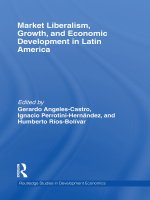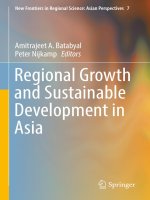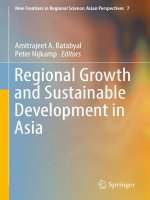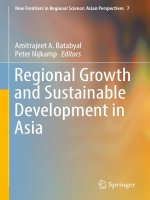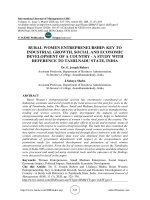Economic growth and economic development 56
Bạn đang xem bản rút gọn của tài liệu. Xem và tải ngay bản đầy đủ của tài liệu tại đây (135.54 KB, 1 trang )
Introduction to Modern Economic Growth
Assumption 1. (Continuity, Differentiability, Positive and Diminishing Marginal Products, and Constant Returns to Scale) The production
function F : R3+ → R+ is twice continuously differentiable in K and L, and satisfies
∂F (K, L, A)
> 0,
∂K
∂ 2 F (K, L, A)
< 0,
FKK (K, L, A) ≡
∂K 2
FK (K, L, A) ≡
∂F (K, L, A)
> 0,
∂L
∂ 2 F (K, L, A)
FLL (K, L, A) ≡
< 0.
∂L2
FL (K, L, A) ≡
Moreover, F exhibits constant returns to scale in K and L.
All of the components of Assumption 1 are important. First, the notation F :
R3+
→ R+ implies that the production function takes nonnegative arguments (i.e.,
K, L ∈ R+ ) and maps to nonnegative levels of output (Y ∈ R+ ). It is natural that
the level of capital and the level of employment should be positive. Since A has
no natural units, it could have been negative. But there is no loss of generality in
restricting it to be positive. The second important aspect of Assumption 1 is that F
is a continuous function in its arguments and is also differentiable. There are many
interesting production functions which are not differentiable and some interesting
ones that are not even continuous. But working with continuously differentiable
functions makes it possible for us to use differential calculus, and the loss of some
generality is a small price to pay for this convenience. Assumption 1 also specifies
that marginal products are positive (so that the level of production increases with
the amount of inputs); this also rules out some potential production functions and
can be relaxed without much complication (see Exercise 2.4). More importantly,
Assumption 1 imposes that the marginal product of both capital and labor are
diminishing, i.e., FKK < 0 and FLL < 0, so that more capital, holding everything
else constant, increases output by less and less, and the same applies to labor.
This property is sometimes also referred to as “diminishing returns” to capital and
labor. We will see below that the degree of diminishing returns to capital will play a
very important role in many of the results of the basic growth model. In fact, these
features distinguish the Solow growth model from its antecedent, the Harrod-Domar
model (see Exercise 2.13).
42
